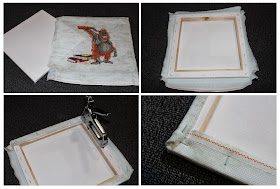 |
| Some of my finished & framed projects from last week. |
2. Ironing: Place your stitching face down over a fluffy towel and keep the iron on a low setting. It's a good idea to cover your work with a thin clean cloth to prevent damage. I tend to sprinkle water over the project to get out the more stubborn wrinkles, although I have read plenty of instructions/tip guides that say to avoid steam. Each to their own I guess.
3. Choosing your frame: hoop, wooden frame, plastic/metal frame, stretched canvas. There are so many options out there and the choice is, of course, entirely up to you! As I said, I'm trying to do this without it costing me a fortune, so I tend to raid the cheapy dollar shops in town, and keep an eye on the sales. I've always tended to favour the standard wooden frame however have lashed out recently and tried stretched canvas. My big tip - take your stitching with you when buying a frame rather than relying on your measurements. Otherwise you wind up with some oddly sized frames and no idea what to do with them since they don't fit the project you thought they'd be perfect for. Yes, I'm speaking from recent experience! Remember to keep in mind how much of a boarder you want to leave around your stitching, how big your material is, and whether or not you're using a mount (cardboard frame inside the wooden frame).
.jpg) |
| Frames from my stash - the cheapy shop was having a sale! |
4. Backing: You'll need to stretch your fabric over a mounting board of some description - otherwise it's going to look crinkled/wrinkled in the frame, and it will be hard to see all your hard work. Where possible, I like to use the mount that's come with the frame. Obviously this isn't an option if you're using the mount to display your work, but I don't tend to use mounts unless I'm getting my stitching professionally framed - just a personal choice. The reason I like to use the mount as my backing board is that I know it's going to fit back into the frame! That's the downside of cheaper frames - you don't have a lot of space to play with. A new trick I've recently been trying is to use the glass as my backing board. It does leave your stitching exposed to the elements but providing you're not hanging your stitching in the bathroom, kitchen, or somewhere really dusty or in direct sunlight (eg outside) I'm hoping it will be okay. It also means that I don't have to worry about squishing beads, which is an issue when I don't use a mount. If you are using a different board, use your glass to trace the size onto some thin card - if your cardboard is too thick, it won't fit in the frame. It's better to cut the board a little smaller than the glass than a little bigger - too big and again it won't fit!
 |
| Position over your mounting board (or glass), and use your left-over thread to lace the edges of your fabric together. Once secure, position back in the frame (taking car of the top and bottom side!) |
5. Lacing: The other good thing about using the glass as a mounting board is that I can see where my stitching is positioned while I lace. Lacing is the process of stitching the edges of your material together to hold them in position over the mounting board. Professional framing guides will tell you to use pins or tacks to hold your stitching in place once you've worked out how to position it on the mounting board. I've always tended to risk it, which does mean I occasionally need to reposition and redo the lacing! The pictures above will show you my lacing steps, as well as showing off glass vs mounting board.
6. In the Frame: Once laced, you just need to pop the stitching into the frame, put the back board on, and you're ready to go. I've taken to taping down the back of my board to make sure dust doesn't get in, and to hold it all together when I've used a different mounting board and things are a little tight in the frame. Just make sure your tape is acid free!
+(800x533).jpg) |
| Taping the back shut |
 |
| Framing over stretched canvas |

.jpg)
great job! Might have to get you around to do some of mine... or else I had been get busy and make some into the quilts and wallhangings I have been dreaming about.
ReplyDeleteI'll have to bring some frames around with me on Thursday. :) Or at least bring some motivation with me!
Delete